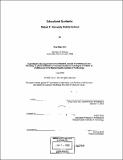Educational quotients : Robert F. Kennedy Middle School
Author(s)
Kim, Paul Hyun, 1971-
DownloadFull printable version (8.211Mb)
Alternative title
EQ : Educational quotients : Robert F. Kennedy Middle School
Other Contributors
Massachusetts Institute of Technology. Dept. of Architecture.
Advisor
Peter Testa.
Terms of use
Metadata
Show full item recordAbstract
When architects talk of 'smart buildings' they are usually referring to the same old ones with the addition of simple prosthetics such as light sensors and small electric motors. Their smartness is invariably limited to the smartness of the trickster. I have sought to develop a strategy which traces a line between the ideal and the pragmatic; it points towards an alternative morphology where the result is not necessarily a discrete zoning of functions, nor prescription of form, but would allow for and support a flexible, dynamic organization that is responsive to the fluctuating energies of technology in space. The complex is motivated by the need to install into the American landscape new attitudes towards study, leisure, and nature. It provides to both the student and the community with spaces that are optimized for disseminating information; these shifting interior landscapes act as parallel horizons, allowing flexible walls, spaces, and rooms to be formed and transformed by different media, as well as the space's intended function. The architectural possibility is achieved by the use of gantries, ramps, and an open plan, all structured through activities that are not restricted by past programmatic conventions.
Description
Thesis (M.Arch.)--Massachusetts Institute of Technology, Dept. of Architecture, 2002. Includes bibliographical references (leaves 43-44).
Date issued
2002Department
Massachusetts Institute of Technology. Department of ArchitecturePublisher
Massachusetts Institute of Technology
Keywords
Architecture.